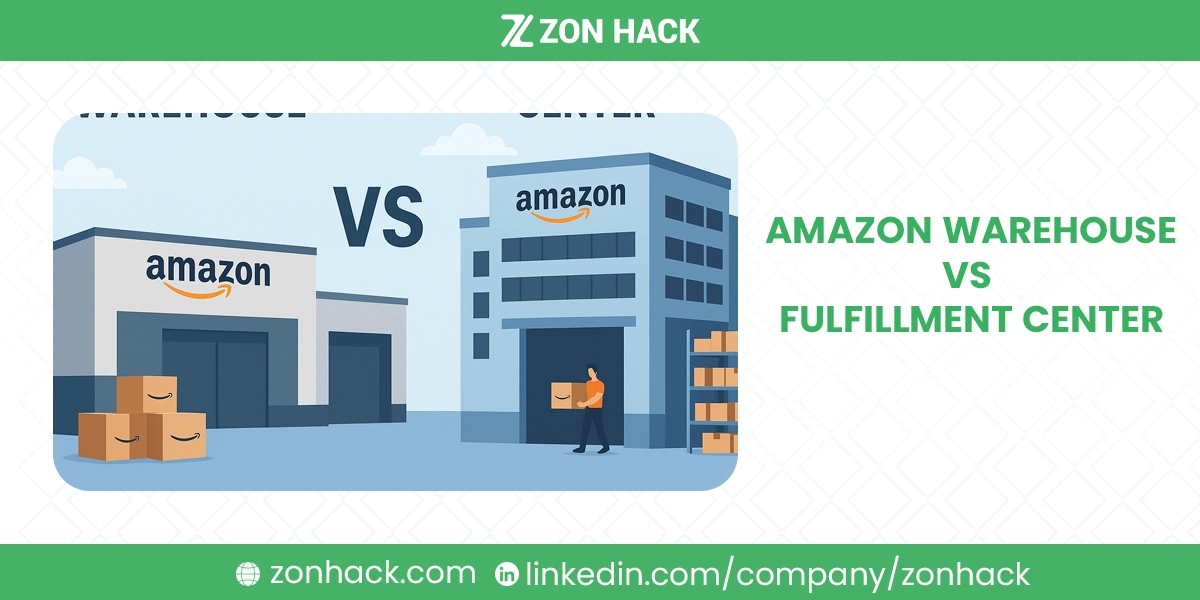When I first started learning about Amazon’s logistics, I quickly realized that people often confuse warehouses and fulfillment centers. At first glance, they might look the same—big buildings full of boxes and shelves. But in reality, they serve two very different purposes.
In this article, I’ll break down the difference between Amazon warehouses and fulfillment centers in simple terms. I’ll also explain why this matters so much for sellers like us. By the end, you’ll know exactly which option is better depending on your business needs.
What Is an Amazon Warehouse?
It’s all about long-term storage and keeping things secure.
An Amazon warehouse is, in simple terms, a large building used primarily for storing products over an extended period. I like to think of it as the storage unit for the really big stuff, or the stuff that’s not needed right now. It serves as a bulk storage space where inventory can be held until it’s actually needed.
Warehouses are often used by companies that require long-term storage for products. Imagine you sell super popular Christmas decorations—you might need a place to store that huge excess inventory right after the holiday season, until the next one rolls around. That’s a perfect job for a warehouse! The focus here is on holding inventory rather than constantly moving it.
Warehouses typically have a pretty static, or unchanging, operational flow. Goods are received in large batches, stored for a while, and then eventually moved out, often in equally large quantities. You’ll see things like moving products with forklifts, stocking shelves way up high, and inventory transfers between locations. You won’t see a lot of people rushing to grab one item for a specific customer, though. The day-to-day handling of individual customer orders is minimal to non-existent here.
Since the items sit on the shelves for longer periods, warehouses tend to have fewer employees and lower activity levels compared to their fulfillment center counterparts. Some of these warehouses might be private (owned directly by Amazon, for example), public (rented out to multiple different companies), or even bonded (for goods that are still controlled by customs). Their profit is tied mainly to storage fees—they make money because your product is taking up space on their shelf for a long time.
What Is an Amazon Fulfillment Center?
This is where the magic of quick delivery truly happens.
An Amazon fulfillment center is also a facility where inventory is kept, but it has a very different purpose and set of activities. If the warehouse is the storage unit, the fulfillment center is the bustling airport. The core function of a fulfillment center is fast-moving inventory turnover and the rapid processing of individual customer orders. This is the place that’s always on the move.
Fulfillment centers are incredibly active, buzzing with employees and sometimes robots! This place is focused entirely on getting that order you just placed online to your doorstep as quickly as possible.
The people working inside are busy with a constant flow of essential tasks:
- Receive inbound inventory shipments—taking in products from sellers or manufacturers.
- Pick individual products to fulfill specific customer orders—this is often called “picking.” Someone literally goes and grabs that one book or t-shirt you ordered.
- Pack and label boxes carefully to minimize damage—making sure your order is safe on its journey.
- Ship orders quickly to end consumers—getting the package onto the right truck.
- Process customer returns and exchanges—handling items coming back from customers.
The entire goal is to efficiently move products out to customers rather than long-term storage. You generally won’t see items staying in a fulfillment center for more than a month or so. It’s designed for speed!
Fulfillment centers also often provide helpful, value-added services. These can include kitting (which is bundling multiple products together as one item), light assembly, and detailed inventory management. They rely on advanced technology systems for tracking orders and inventory, optimizing shipping routes with carriers like UPS or FedEx, and using automation in packing and shipping to save time.
Profitability for a fulfillment center is tied directly to inventory movement—the more orders shipped, the more revenue is generated. This is a stark contrast to warehouses that earn their keep mainly from those storage fees.
Additional Differences and Roles
The logistics world has a few other players, too, and they’re easy to confuse.
The logistics world can be a real alphabet soup of terms, so let’s clarify a few more differences that help us understand the unique role of a fulfillment center compared to a traditional warehouse.
Fulfillment centers focus heavily on both B2C (Business-to-Consumer) and B2B orders, but the B2C side is their bread and butter. Their operations are hyper-focused on meeting those tight delivery windows and ensuring high customer satisfaction. When you order one specific item from Amazon, a fulfillment center is the one making it happen.
Warehouses mainly support wholesale or large-volume inventory storage without the direct-to-consumer shipping component. They are the holding tanks for huge amounts of inventory that might eventually be shipped to a fulfillment center or a retail store, but they aren’t mailing individual packages to you.
It’s also worth quickly mentioning Distribution Centers. These are often confused with both of the above! A distribution center typically serves as a transfer point for bulk goods moving between manufacturers and retail stores. They often receive large shipments and break them down into smaller, yet still large, shipments for delivery to specific retail locations. Like warehouses, they are not usually about shipping directly to the individual consumer.
Finally, you’ll hear about Third-Party Logistics companies (3PLs). These companies often operate fulfillment centers, providing a complete, end-to-end logistics service. This includes the storage, the picking, the packing, and the shipping—the whole nine yards. They are logistics experts you can hire.
Why It Matters for Amazon Sellers
Choosing the right facility can make or break a business’s growth and customer experience.
If you are an Amazon seller, or if you run any kind of e-commerce business, understanding these differences isn’t just academic—it’s crucial for your success. Choosing the right kind of facility for your inventory is a major business decision.
Here is the simple breakdown:
- If your business needs a safe, cost-effective place to just store inventory for a while (maybe you have excess stock, or you’re holding seasonal products until the next selling cycle), an Amazon warehouse is the suitable, long-term storage solution.
- However, if fast shipping of individual orders to your customers is critical to your business—and let’s be honest, it is for almost all Amazon businesses—then using an Amazon fulfillment center (like those used in the Fulfilled by Amazon or FBA programs) is absolutely essential.
Fulfillment centers offer some seriously great benefits that sellers can’t easily get on their own. They provide things like:
- Volume shipping discounts because they ship millions of packages.
- Optimized geographic locations for fast delivery to customers all across the country.
- Flexible warehouse space that can grow or shrink with your sales.
- Expert logistics management without you having to hire your own in-house staff.
Ultimately, outsourcing your fulfillment process to professional fulfillment centers allows you, the seller, to focus on the things that matter most: growth, marketing, product development, and customer service. You can rest easy knowing that the complex, day-to-day logistics of storage, picking, packing, and shipping are operating smoothly in the hands of experts. It’s a huge weight off your shoulders!
Conclusion
At the end of the day, Amazon warehouses and fulfillment centers may look similar but they’re built for different purposes. Warehouses are like the quiet storage rooms where products rest until needed. Fulfillment centers, on the other hand, are the busy engines that drive fast delivery and customer satisfaction.
For sellers, the choice depends on your business model. If you need to store bulk or seasonal products, warehouses make sense. But if quick order fulfillment and happy customers are your top priorities, fulfillment centers are the way to go.




